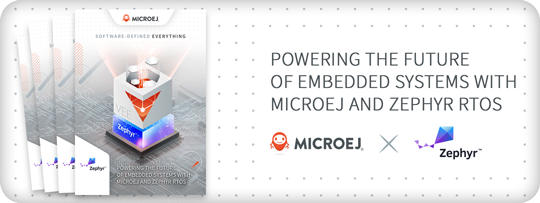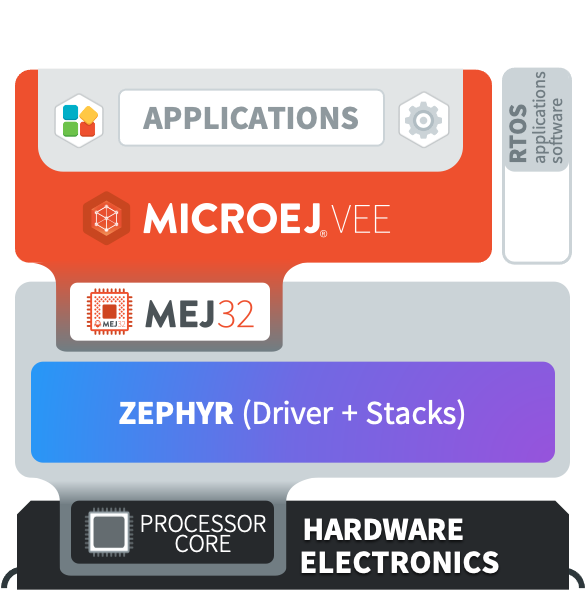Synergy Between MicroEJ and Zephyr
The power to redefine how embedded systems are designed, developed, and monetized.
The power to redefine how embedded systems are designed, developed, and monetized.

In the mobile world, the combination of Linux and Android created a revolution. Linux provided a powerful, scalable OS for mobile hardware, while Android added an application framework, virtualization, and a rich app ecosystem. This combination transformed mobile phones from single-purpose communication tools into dynamic, software-defined platforms that continuously evolve through software updates and app-driven innovation.
Now, the embedded world is on the verge of a similar transformation. Zephyr RTOS is emerging as the Linux equivalent for embedded systems, providing a lightweight, secure, and real-time foundation that runs on a vast array of hardware platforms. And to truly unlock the potential of software-defined embedded devices, MicroEJ acts as the Android-like layer, adding containerization, managed code, and multi-sandboxing to enable app-driven innovation.

Zephyr RTOS is quickly becoming the go-to operating system for IoT and embedded devices due to its scalability, modularity, and security. It offers:
Zephyr brings Linux-inspired innovations like device and driver support, simplifying one of embedded development’s biggest challenges: hardware support.
However, Zephyr alone is not enough to enable software-defined flexibility at scale. Indeed, it is an embedded RTOS and framework, not an application platform. Product developers limiting themselves to what Zephyr offers risk to face commoditization— with devices lacking distinguishable trait, reducing differentiation and margin potential.
MicroEJ extends Zephyr by introducing a secure, lightweight virtual execution environment (VEE) that enables embedded devices to run managed code within isolated software containers. This approach mirrors how Android separates application and firmware layers by running Java/Kotlin apps on Linux, allowing for:
MicroEJ removes application development barriers, empowering developers and enabling product owners to drive differentiation through software updates and ecosystem enhancements. Manufacturers can foster developer communities that expand product capabilities, ensuring long-term engagement and innovation.
Traditional embedded development has long been constrained by tight hardware-software dependencies, where applications are tightly coupled to the hardware, and adding new features often required a complete product redesign.
Zephyr speeds up firmware development for any hardware, while MicroEJ provides an application platform free from hardware dependencies. Together, they enable manufacturers to build devices that are:
MicroEJ is proud to be a Silver Member of the Zephyr Project, and together, we are showcasing the power of our combined technologies at Embedded World 2025.
Join us at Zephyr’s booth in Nuremberg, Germany, from March 11 – 13, 2025, to experience a live demo showcasing how MicroEJ and Zephyr RTOS pave the way for the future of embedded systems!
Head over to the MICROEJ VEE product page for an in-depth look at its architecture and features. Discover how it can streamline your development process and unlock new possibilities for your projects.